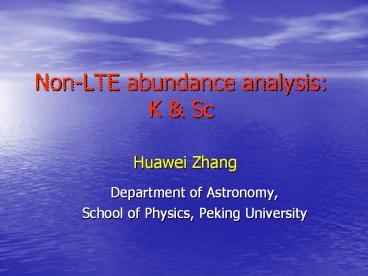Non-LTE abundance analysis: K - PowerPoint PPT Presentation
Title:
Non-LTE abundance analysis: K
Description:
School of Physics, Peking University. Collaborators: Thomas Gehren (LMU) Keith Butler (LMU) ... The low mass unevolved stars have long lifetimes, some of them ... – PowerPoint PPT presentation
Number of Views:22
Avg rating:3.0/5.0
Title: Non-LTE abundance analysis: K
1
Non-LTE abundance analysisK Sc
- Huawei Zhang
- Department of Astronomy,
- School of Physics, Peking University
2
Collaborators
- Thomas Gehren (LMU)
- Keith Butler (LMU)
- Shi Jianrong (NAOC)
- Zhao Gang (NAOC)
3
- The history of the Galaxy is written in the
evolution of its composition. - The low mass unevolved stars have long lifetimes,
some of them have comparable to the age of the
Galaxy. - Their atmospheric compositions have preserved
much of their natal interstellar clouds.
4
- The determination of the element abundances in
stars of different metallicities is important for
understanding the chemical evolution of the Milky
way.
5
Abundance analysis
- Still today, the vast majority of abundance
analyses of late-type stars rely on the
assumption of local thermodynamic equilibrium
(LTE). - Departures from LTE are common place and often
quite important.
6
LTE vs. NLTE
- LTE The level populations can be directly
computed from the local gas temperature by the
use of the Boltzmann and Saha distributions. - NLTE These rate equations must be solved
simultaneously with radiative transfer equation
for all relevant frequencies.
7
- K (Z19) and Sc (Z21) are odd-Z elements.
8
K Sc NLTE model
K
Sc
9
K lines LTE vs. NLTE
KI 7698
10
Potassium results the Sun
Zhang et al., 2006, AA, 453, 723
- Average solar potassium abundance
- log ??(K) 5.120.03
- Corresponds to the meteoritic value (Grevesse
Sauval, 1998).
11
Potassium results metal-poor stars Zhang et
al., 2006, AA, 457, 645
- 58 metal-poor stars
- DSAZ FOCES
- R 40000
- S/N 100-200
12
- The NLTE corrections for metal-poor stars are
negative and the average of -0.40 dex.
13
Potassium results metal-poor stars Zhang et
al., 2006, AA, 457, 645
Samland(1998)
Goswami Prantzos (2000)
Timmes et al. (1995)
14
Scandium results the Sun
Zhang et al., 2008, AA, 481, 489
NLTE
LTE
Sc I 5671
LTE
NLTE
Sc II 5526
15
LTE result
Sc II
- Sc I 2.900.09
- Sc II 3.100.05
Sc I
16
NLTE result
- Sc I 3.080.05
- Sc II 3.070.04
Sc I
Sc II
Sc I
Sc II
Sc II
Sc I
17
Scandium results metal-poor stars
Zhang et al., 2008, in preparation
Sc/Fe Fe/H
Thick disk
Halo
Thin disk
18
Thank You !































